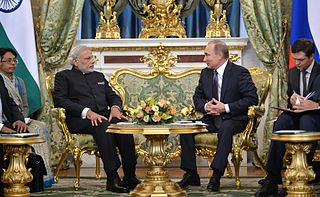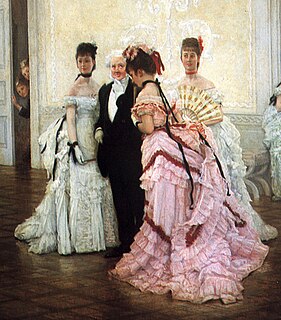
A shirt is a cloth garment for the upper body.

A necktie, or simply a tie, is a piece of cloth worn by men and women for decorative purposes around the neck, resting under the shirt collar and knotted at the throat, and often draped down the chest.

A waistcoat, or vest, is a sleeveless upper-body garment. It is usually worn over a dress shirt and necktie and below a coat as a part of most men's formal wear. It is also sported as the third piece in the traditional three-piece male suit. Any given vest can be simple or ornate, or for leisure or luxury. Historically, the vest can be worn either in the place of or underneath a larger coat dependent upon the weather, wearer, and setting.

A suit, lounge suit, or business suit is a set of clothes comprising a suit jacket and trousers of identical textiles worn with a collared dress shirt, necktie, and dress shoes. It is considered informal wear in Western dress codes. The lounge suit originated in 19th-century Britain as a more casual alternative for sportswear and British country clothing. After replacing the black frock coat in the early 20th century as regular daywear, a sober one-colored suit became known as a lounge suit.

The bow tie is a type of necktie. A modern bow tie is tied using a common shoelace knot, which is also called the bow knot for that reason. It consists of a ribbon of fabric tied around the collar of a shirt in a symmetrical manner, so that the two opposite ends form loops.

Brooks Brothers, founded in Manhattan, New York City in 1818, is the oldest apparel brand in continuous operation in America. Originally a family business, Brooks Brothers produces clothing for men, women and children, as well as home furnishings. Designer Zac Posen was the brand's women's collection creative director from June 2014 until 2020. Since December 2020, Michael Bastian has been the brand's creative director for both the men's and women's collections.

1870s fashion in European and European-influenced clothing is characterized by a gradual return to a narrow silhouette after the full-skirted fashions of the 1850s and 1860s.

Cufflinks are items of jewelry that are used to secure the cuffs of dress shirts. Cufflinks can be manufactured from a variety of different materials, such as glass, stone, leather, metal, precious metal or combinations of these. Securing of the cufflinks is usually achieved via toggles or reverses based on the design of the front section, which can be folded into position. There are also variants with chains or a rigid, bent rear section. The front sections of the cufflinks can be decorated with gemstones, inlays, inset material or enamel and designed in two or three-dimensional forms.

Morning dress, also known as formal day dress, is the formal Western dress code for day attire, consisting chiefly of, for men, a morning coat, waistcoat, and formal trousers, and an appropriate gown for women. Men may also wear a popular variant where all parts are the same colour and material, often grey and usually called "morning suit" or "morning grey" to distinguish it; considered properly appropriate only to festive functions such as summer weddings and horse races, which consequently makes it slightly less formal. The correct hat would be a formal top hat, or if on less spacious audience settings optionally a collapsible equivalent opera hat.

A dress shirt, button shirt, button-front, button-front shirt, or button-up shirt, is a garment with a collar and a full-length opening at the front, which is fastened using buttons or shirt studs. A button-down or button-down shirt is a dress shirt which has a button-down collar – a collar having the ends fastened to the shirt with buttons.

1850s fashion in Western and Western-influenced clothing is characterized by an increase in the width of women's skirts supported by crinolines or hoops, the mass production of sewing machines, and the beginnings of dress reform. Masculine styles began to originate more in London, while female fashions originated almost exclusively in Paris.

Fashion of the 1980s placed heavy emphasis on cheap clothes and fashion accessories and very big poofy hair. Apparel tended to be very bright and vivid in appearance. Punk fashion began as a reaction against both the hippie movement of the past decades and the materialist values of the current decade. The first half of the decade was relatively tame in comparison to the second half, which is when the iconic 1980s color scheme had come into popularity.

Fashion in the 1970s was about individuality. In the early 1970s, Vogue proclaimed "There are no rules in the fashion game now" due to overproduction flooding the market with cheap synthetic clothing. Common items included mini skirts, bell-bottoms popularized by hippies, vintage clothing from the 1950s and earlier, and the androgynous glam rock and disco styles that introduced platform shoes, bright colors, glitter, and satin.

Fashion from 1910–1919 in the Western world was characterized by a rich and exotic opulence in the first half of the decade in contrast with the somber practicality of garments worn during the Great War. Men's trousers were worn cuffed to ankle-length and creased. Skirts rose from floor length to well above the ankle, women began to bob their hair, and the stage was set for the radical new fashions associated with the Jazz Age of the 1920s.

Charvet Place Vendôme, pronounced [ʃaʁvɛ plas vɑ̃dɔm], or simply Charvet, is a French high-end shirt maker and tailor located at 28 Place Vendôme in Paris. It designs, produces and sells bespoke and ready-to-wear shirts, neckties, blouses, pyjamas and suits, in the Paris store and internationally through luxury retailers.
A man's suit of clothes, in the sense of a lounge or business or office suit, is a set of garments which are crafted from the same cloth. This article discusses the history of the lounge suit, often called a business suit when featuring dark colors and a conservative cut.

Evander Berry Wall was a New York City socialite and later an American expatriate in France during the Belle Époque and beyond. He was famous for his extravagantly refined look and was crowned "King of the Dudes" in the 1880s.
Countess Mara, founded in 1935 by Lucilla Mara de Vescovi, was an Italian menswear fashion label specialising in high-end pictorial neckties. The brand has been owned by Randa Accessories since 1998.
Ralph Lauren Corporation is an American publicly traded fashion company that was founded in 1967 by American fashion designer Ralph Lauren. The company is headquartered in New York City, and it produces products ranging from the mid-range to the luxury segments. They are known for the marketing and distribution of products in four categories: apparel, home, accessories, and fragrances. The company's brands include the mid-range Chaps brand, to the sub-premium Lauren Ralph Lauren brand, to the premium Polo Ralph Lauren, Double RL, Ralph Lauren Childrenswear, and Denim & Supply Ralph Lauren brands, up to the full luxury Ralph Lauren Purple Label and Ralph Lauren Collection brands.
















